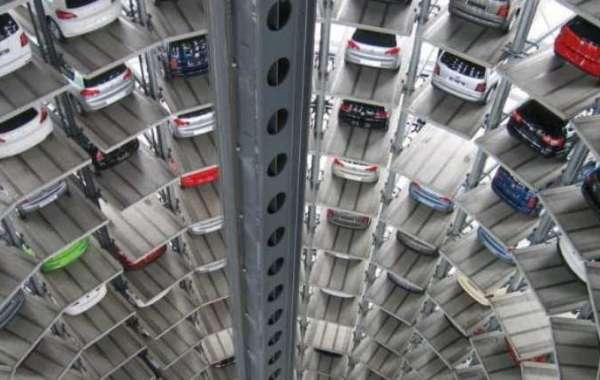New age multi-level automated car parking systems are one of the biggest boons for urban people who, to date, have been struggling with cramped roads and a lack of suitable parking slots. The advent of multi-level parking systems entails lower operational, maintenance, and construction costs and proves to be more environment-friendly, with open spaces for landscaping.
A recent survey conducted by ELENA POLYCARPOU, Research Associate, KIOS Research Center for Intelligent Systems and Networks, reported that approximately 40% of drivers spend 10-30 minutes searching for a parking space. In another research, the Centre for Science and Environment (CSE) stated that, in India, a car is parked for more than 95% of the time and is driven for less than 5% of the time. If one were to consider the economics, car parks use valuable land, at least in the metros, which can be monetized through urban planning and architecture. INRIX studied drivers’ parking behavior in 30 cities in the UK, US, and Germany and projected that the combined cost in wasted time, fuel, and carbon emissions to the economies of these countries was close to $200 billion a year.
With demand expanding constantly, and to accommodate rapid urbanization, the construction of multi-level car parking system facilities augur well for the comfort of the people and has a multiplier impact on the economy. Moreover, the growing demand for smart infrastructure at airports, shopping malls, and similar public places is pushing the demand for smart parking systems. A recent report by Markets Markets points out that the global automated parking system market is projected to grow at a CAGR of 13.1% from 2019 to 2027, to reach a market size of US$3.6 billion by 2027. The increasing number of vehicles, scarcity of land for parking, rising urbanization, growing demand for green sustainable parking solutions, increasing demand for luxury buildings, and smart cities initiatives from the government are some of the factors augmenting the growth of multi-level parking systems in the country.
For some time now, multi-level Parking systems have been providing relief to the public since they offer several advantages – optimal utilization of space, lower maintenance and operational cost, lower construction cost (owing to the prefabrication), secure and environment-friendly nature (the underground implementation renders the outdoor space accessible for landscaping), comfortable for the drivers, cost-saving for builders by saving height/depth.
Automated Multilevel Car Parking System (AMLCP)
Steelion envisions implementing outstanding parking technology all over the world to solve the growing parking problem. By working on customized client requirements, carefully combining technical commercial viability, and ensuring environment-friendliness, Steelion delivers what it promises – utmost comfort backed by new-age technology.
Steelion car parking systems possess a modular design approach that subdivides a complex system into smaller parts – modules that can be independently created and installed. The parking system is a nut-and-bolt steel structure installation, implying that it can be dismantled and relocated to a new place quickly and cost-effectively if required. Steelion’s customized car parking solution is a viable option for but is not limited to, the following project categories: Hospitals; Shopping malls, IT Park and Offices, Public Transport Projects, and Airports. Steelion offers various parking systems, such as an Easy Parking System, High-Density Parking System, Ultra-Density Parking System, and Underground Parking System.
To offer greater convenience to people visiting malls, there is a strong demand for ample parking space, which is also easily accessible. If not all then at least most of the time, a parking system determines a shopper’s first and last impression of a mall. These factors are the driving reasons behind the advent of multi-level automated parking systems at malls. Another interesting avenue that is fast capturing the attention of smart parking system companies is the Movie Theatres, especially in metro cities, where parking spaces are a rarity. A case in point is the iconic Metro Cinemas located in South Mumbai, where the soaring real estate prices are anyone’s guess. When the theater got renovated a few years back, it recognized the trouble that moviegoers had to go through for parking. With a view to solving this problem, the theater has capitalized on an automated multi-level parking system which not only saves on space but also ensures that a greater number of cars are parked in a limited space and offers people the much-needed convenience that they had been looking for.
In tandem with this, Robopark – our Robotic Car Parking System – is a fully automated car parking system requiring no operator for managing the functional aspects. The system performs both horizontal and vertical motions simultaneously (Diagonal Movement of the unit). This technology saves valuable time since each motion requires acceleration, full-speed running, deceleration, and tuning phases. The system is also equipped with the technology for regenerating electric power from Kinetic Energy. Robopark can retrieve the car from any parking slot in less than 2 minutes in the Easy Park Model. This is made possible by implementing the latest technologies of robotic parking, making it one of the fastest Automated Parking Systems in the industry. The system has weather-proof cladding, which keeps the parked cars in clean condition and enhances the lifespan of the parking system. A robotic parking system is one of the most energy-efficient automated parking systems present globally, with just 0.3 Units (KWh) of energy consumption for parking and retrieving a single car. With all these more, Steelion has firmly positioned itself as one of the most undisputed leaders in making car parking a hassle-free affair.
FACTS
- The earliest use of an automated parking system (APS) was in Paris, France in 1905 at the Garage Rue de Ponthieu. The APS consisted of a groundbreakingmulti-story concrete structure with an internal car elevator to transport cars to upper levels where attendants parked the cars.
- In the 1920s, a Ferris wheel-like APS (for cars rather than people) called a paternoster system became popular as it could park eight cars in the ground space normally used for parking two cars. Mechanically simple with a small footprint, the paternoster was easy to use in many places, including inside buildings. At the same time, Kent Automatic Garages was installing APS with capacities exceeding 1,000 cars.
- The first driverless parking garage opened in 1951 in Washington, D.C., but was replaced with office space due to increasing land values.






